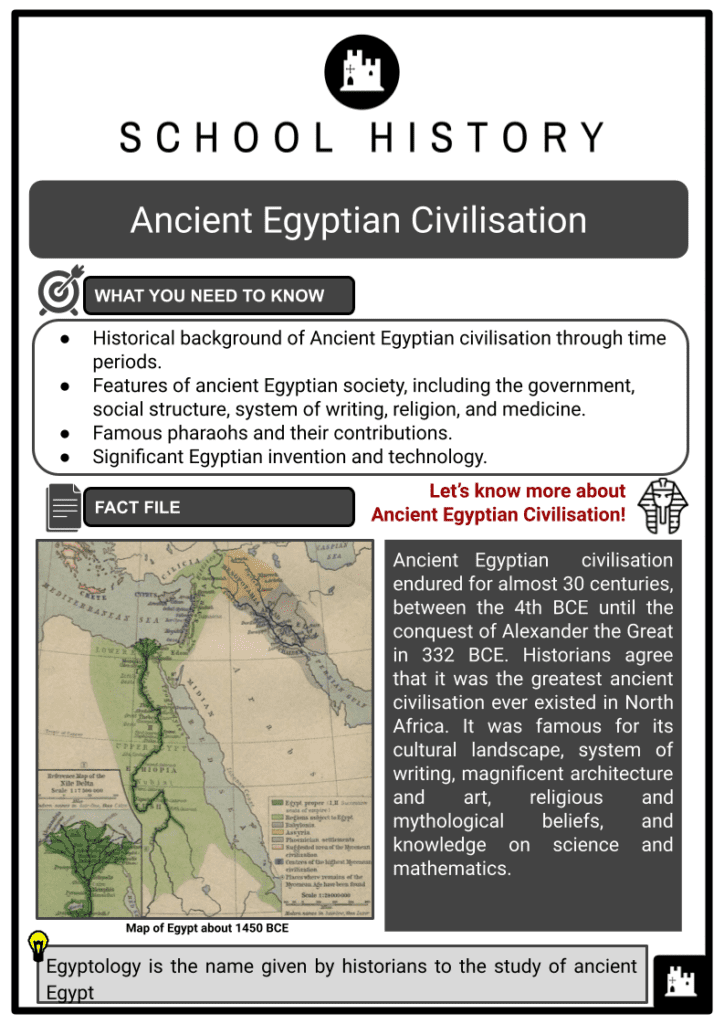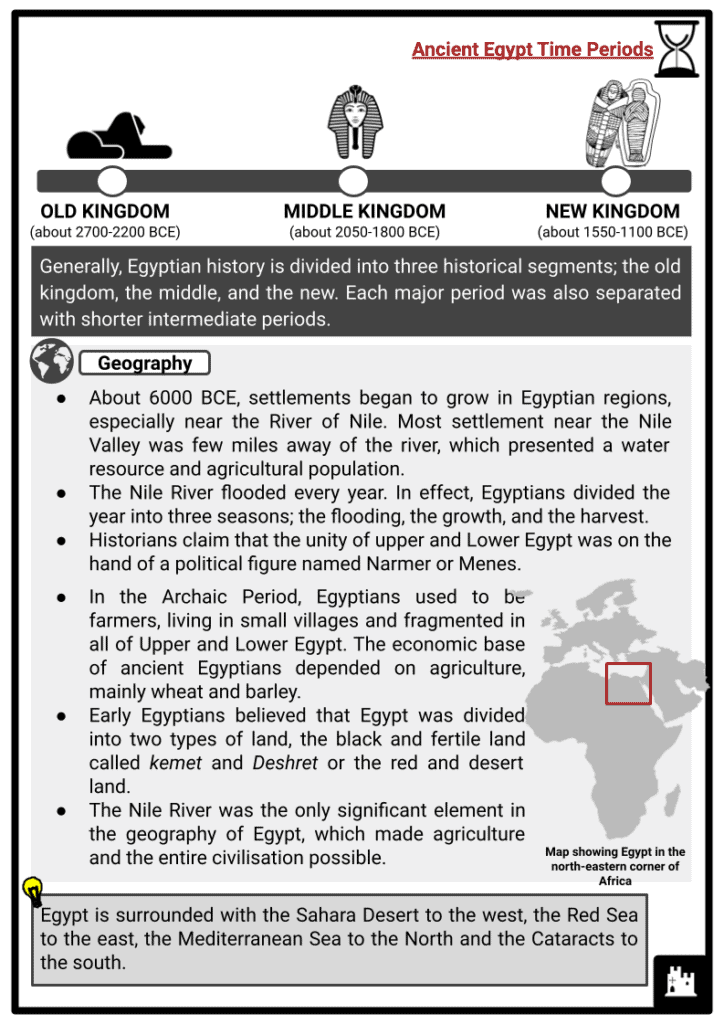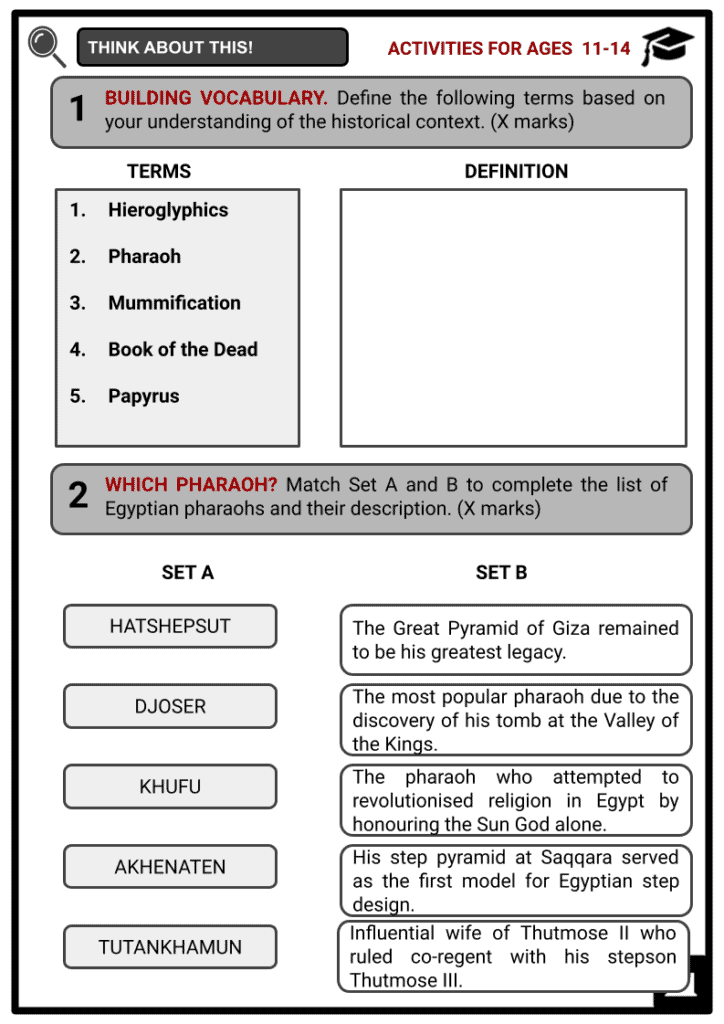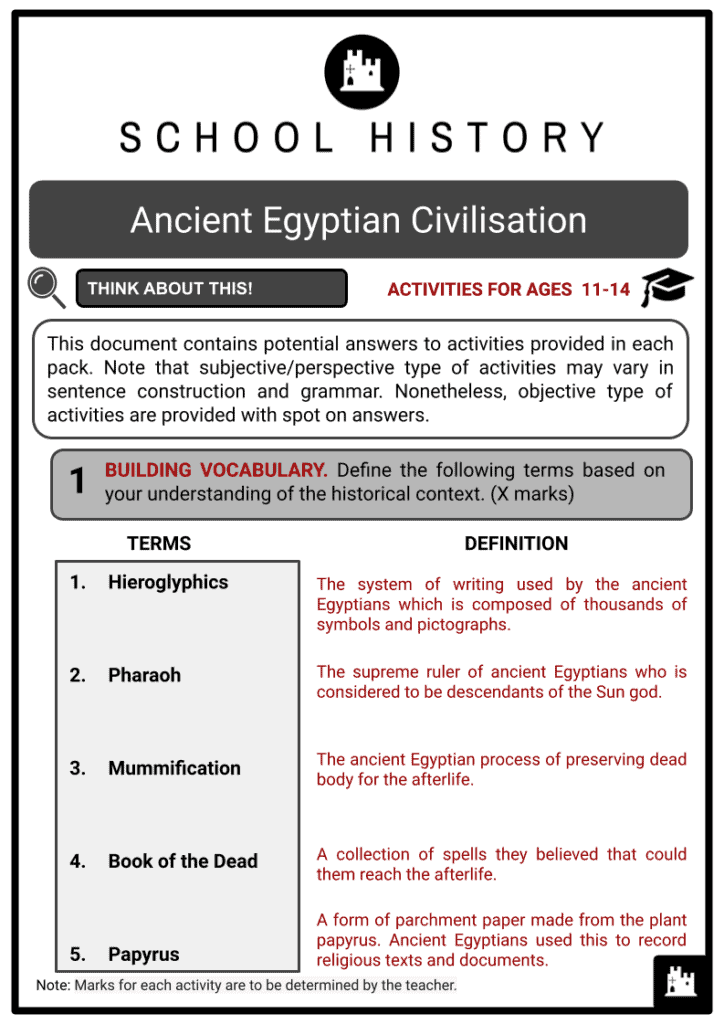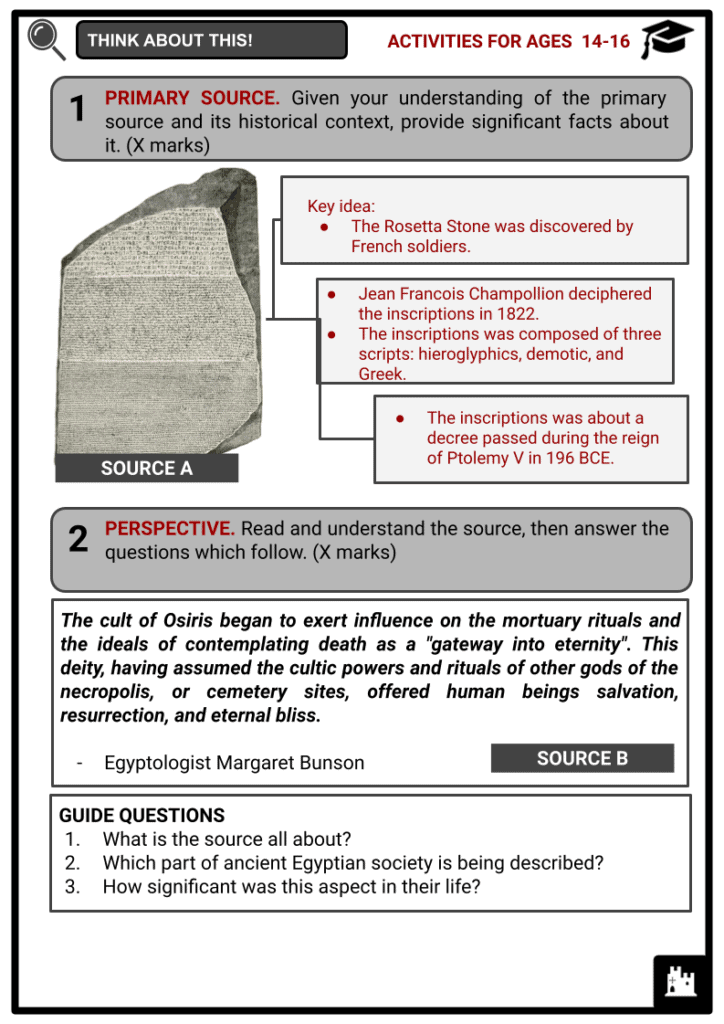Download Ancient Egyptian Civilisation Worksheets
Do you want to save dozens of hours in time? Get your evenings and weekends back? Be able to teach Ancient Egyptian Civilisation to your students?
Our worksheet bundle includes a fact file and printable worksheets and student activities. Perfect for both the classroom and homeschooling!
Summary
- Historical background of Ancient Egyptian civilisation through time periods.
- Features of Ancient Egyptian society, including the government, social structure, system of writing, religion, and medicine.
- Famous pharaohs and their contributions.
- Significant Egyptian invention and technology.
Key Facts And Information
Let’s learn more about Ancient Egyptian Civilisation!
- The Ancient Egyptian civilisation endured for almost 30 centuries, between 3100 BCE until the conquest by Alexander the Great in 332 BCE. Historians agree that it was the greatest ancient civilisation that ever existed in North Africa. It was famous for its cultural landscape, system of writing, magnificent architecture and art, religious and mythological beliefs, and knowledge of science and mathematics.
- Egyptology is the name given by historians to the study of ancient Egypt.
Ancient Egyptian Time Periods
Generally, Egyptian history is divided into three historical segments: the Old Kingdom, the Middle Kingdom, and the New Kingdom. Each major period was also separated with shorter intermediate periods.
Geography
- About 6000 BCE, settlements began to grow in Egyptian regions, especially near the Nile River. Most settlements near the Nile Valley were a few miles away from the river, which provided a water resource and agricultural fertility.
- The Nile River floods every year. In effect, Egyptians divided the year into three seasons; the flooding, the growth, and the harvest.
- Historians claim that the unification of Upper and Lower Egypt was achieved by a political figure named Narmer, or Menes.
- In the Archaic Period, Egyptians used to be farmers, living in small villages and spread throughout all of Upper and Lower Egypt. The economic base of ancient Egyptians depended on agriculture, mainly wheat and barley.
- Early Egyptians believed that Egypt was divided into two types of land, the black and fertile land called kemet and the red and desert land called deshret.
- The Nile River was the only significant element in the geography of Egypt. This river made agriculture and the entire civilisation possible.
- Egypt is surrounded by the Sahara Desert to the west, the Red Sea to the east, the Mediterranean Sea to the North, and the Cataracts to the south.
Early Dynastic Periods (Dynasties I-III)
- In addition to kingdoms, historians used dynasties and periods to outline the history of Ancient Egypt.
- Beginning from the Ptolemaic Dynasty founded by the Greeks, there were over 30 dynasties that ruled Ancient Egypt for over 3,000 years. A dynasty is characterised by families who passed the title and power of pharaoh from one family member to another.
- In each kingdom, there are intermediate periods used to discuss the timeline of Ancient Egypt.
- The first pharaoh was Menes, who united the upper and lower regions of Egypt into one civilisation, with Memphis as capital (located at the midpoint of the two regions).
- After the unification of Ancient Egypt, an idea of a divine pharaoh developed. This is the idea that a ruler or a king is given the right to rule from the gods. It was believed that Menes was depicted as Horus (an Egyptian god thought of as the god of Lower Egypt), who defeated “Set”, the god of Upper Egypt. This was a mythology fused with real political events to support the legitimacy of kingship.
- Egyptians believed that it was during this period when hieroglyphic writing was developed and was used in making records.
Old Kingdom (Dynasties IV-VIII)
- Around 2630 BCE, the Old Kingdom was marked by the reign of the third dynasty of pharaohs and characterized by the building of enormous pyramids.
- Pharaoh Djoser demanded Imhotep, an architect, to build a funerary mastaba for him. When the king died, the architect made the Step-Pyramid at Saqqara, which was the first major stone building in Egypt. The stone construction reached its apex with the building of the Great Pyramid of Giza.
- This pyramid was built for Khufu, who ruled Egypt from 2589 to 2566 BCE. The Great Pyramid of Giza was classified by historians as one of the Seven Wonders of the Ancient World. Then, two other pyramids were raised to honour Pharaoh Khafra (2558-2532 BCE) and Pharaoh Menkaure (2532-2503 BCE).
- Egypt prospered economically, artistically, and scientifically during the peaceful era of the third and fourth dynasties.
- The kings of that period provided stability and unity across all of Ancient Egypt. These pharaohs also expanded west to conquer Libya and south to rule Nubia. Those expansions made Egypt wealthier.
- During the fifth and sixth dynasties, the state’s wealth was decreasing. This economical decline was due to the costs of pyramid construction.
- Thus, the state, being the king, became weaker in power, which left room for priesthood and nobility to ascend as a firm political leader. The Old Kingdom ended with the death of the sixth dynasty and King Pepi II.
First Intermediate Period (Dynasties IX-XI)
- The first intermediate period began with the assassination of the 11th dynasty king, Mentuhotep IV. His vizier held the throne of Egypt and became king of the 12th dynasty. During the rule of Amenemhet I, the prior vizier, a new capital was established south of Memphis. However, Thebes continued to be a great religious centre. After the chaos Egypt experienced at the end of the Old Kingdom period, Ancient Egypt flourished again.
Middle Kingdom (Dynasties XI-XIV)
- In the Middle Kingdom period, Egypt colonised Nubia, draining it of its rich supply of gold, ebony, and ivory. The Egyptians also developed a trade relationship with Palestine and Syria, along with other countries. At that time, Egyptians focused on military projects.
- Egypt reached its apex under the rule of King Amenemhat III, but it then declined under Amenemhat IV. The first intermediate period ended with the rule of the first royal blood female in Egypt, Queen Sobekneferu (1789-1786 BCE).
- The beginning of the Middle Kingdom was marked by the unification of Egypt’s two regions under one rule. Pharaoh Mentuhotep II reunited Egypt and moved the royal tombs to be near the city of Memphis. Also, during this period, irrigation connected to the Nile River was built.
Second Intermediate Period (Dynasties XV-XVII)
- During this period, Egyptian rulers failed to sustain power. Thus, Egypt experienced an unsettled period of time. The capital was again established in Thebes. Chaos prevailed in Egypt until some foreign rulers (known as the Hyksos) took control. However, Egyptian culture was adopted by the new rulers, thus Egyptian culture continued to exist during this period.
- A native Theban ruler of the 17th dynasty paid huge taxes to the Hyksos in order to take control over the southern part of Egypt. He retained great power and started a conflict with the intruders. Soon enough, the Thebans declared war against the Hyksos around 1570 BCE. The war ended with the Hyksos being driven out.
- It was during this period when horse and chariots were introduced.
New Kingdom (Dynasties XVIII-XX)
- In this period, King Ahmose I unified Egypt. At the same time, Egypt began to expand again, conquering other powers and nations, such as the Mitannians and the Hittites. With a very large expansion, Egypt was the first great empire of that time. The Egyptian empire stretched from Nubia to the Euphrates River in Asia.
- Amenhotep IV was the first pharaoh to have made religious radical changes. He commanded the people to worship one god, the creator of all, Amun-Ra. Other deities were not neglected, but they were no longer sacred and worthy of worship. This pharaoh renamed himself Akhenaton, meaning “the servant of Ra”. He established and constructed a new capital in Egypt, and it was called Akhetaten.
- According to Egyptologists, the Valley of the Kings was one of the most famous archeological sites in Ancient Egypt. It was built during the New Kingdom period. Since Pharaoh Thutmose I, kings have been buried in this site. Among the most famous was the tomb of Tutankhamun.
- The power of the Egyptian empire began to decline under the reign of Ramesses III. Battles against foreign invasion and severe famines caused unrest and the weakening of Egypt.
- Moreover, the death of Ramesses III led to corruption and power struggles within the government. Ramesses XI became the last pharaoh of the New Kingdom.
Third Intermediate Period (Dynasties XXI-XXIV)
- The Third Intermediate Period marked major political, social, and cultural changes in Egypt. The 22nd dynasty began around 945 BCE, when King Sheshonq held the throne in Egypt. He was a descendant of Libyans who had invaded Egypt during the late 20th dynasty and settled there.
- In the eighth century BCE, Shabako, a Nubian pharaoh ruled over Egypt. This king raised a conflict against the growing Assyrian empire. In 671 BCE, the Assyrian ruler, Esarhaddon, destroyed the city of Memphis, driving the Nubian ruler out.
- This decline of power that Egypt experienced in that period was due to the economical costs of building the pyramids. Burying the gold and wealth of every person that died also affected the economy. These facts left Egypt crippled, and it could not afford military recruitments.
The Late Period: Alexander the Great’s conquest (c. 664-332 BCE)
- In 525 BCE, the king of Persia, Cambyses, conquered Egypt, and it became part of the Persian Empire. This Persian king kept Egypt’s religious cults and helped in the construction and restoration of its temples.
- In 332 BCE, Alexander the Great of Macedonia destroyed the Persian armies and conquered Egypt. After the death of Alexander the Great, Egypt was ruled by a line of Macedonian kings. The legendary Cleopatra VII was the last ruler of Egypt. In 31 BCE, six centuries of Roman rule over Egypt began. At that particular time, Egypt was Christianised. However, in the seventh century CE, Egypt was conquered by Arabs and introduced to Islam.
Ancient Egyptian society
Government
- In Ancient Egypt, religion and government were inseparable. Aside from the power of rulers, these two brought order to society.
- PHARAOH. The supreme religious and political leader, who was considered to be a direct descendant of gods and a holder of absolute power. Historically, not all pharaohs were Egyptian.
- Most pharaohs were sons or heirs of the previous pharaoh. Others were viziers who assumed leadership and introduced a new line of royal family.
- VIZIERS. Appointed by the pharaoh as his representative, viziers were responsible for overseeing the land, the treasury, building projects, and the legal system. Viziers acted like a prime minister.
- Imhotep was probably the most famous vizier in the history of Ancient Egypt. He built the first pyramid, which later made him into a god.
- ROYAL OVERSEERS. They served as supervisors of the lands worked by peasants.
- DISTRICT GOVERNORS. Also known as nomarks, they were local governors who ruled towns and districts.
- The position of a nomark was hereditary in nature, but on rare occasions, a pharaoh would appoint one.
- SCRIBES. They wrote and kept accounts about the Egyptian society and government, including letters to townspeople, orders of the pharaohs, records of harvests, and expeditions for the army.
- Egypt was divided into nearly 42 administrative regions called nomes.
- Temples were very important in contributing to the wealth of the state. They collected and stored the kingdom's wealth in a system of granaries and treasuries administered by overseers. Thus, the economy was strictly organised and controlled. During the fifth century BCE, the idea of coined money was discovered by Egyptians from foreign countries.
Social structure
- Similar to a pyramid, Ancient Egypt’s social class was structured in a hierarchy. Men, women, and all people from all social classes were equal under Egyptian law. Both genders had the right to own and sell property, marry and divorce, receive inheritance, and make contracts.
- At the top of the hierarchy were pharaohs, who were considered to be gods in human form.
- Laws were enacted under a pharaoh’s discretion. They were buried in tombs within the pyramids.
- Following the pharaoh were government officials, known as nobles and priests. While members of the nobility made and enacted laws, priests kept the gods delighted through ceremonies and rituals.
- Below the nobles were scribes and soldiers. Scribes knew how to read, write and keep records, while soldiers were responsible for defending the empire from foreign threats and for solving domestic uprisings.
- Skilled workers known as craftsmen occupied the second to the last level of the hierarchy. They were pottery makers, leatherworkers, sculptors, weavers, painters, jewelry makers, tailors, and shoemakers who worked in workshops.
- Also a huge part of the population were farmers, who farmed the land of the pharaoh and nobles. They received housing, food, and clothes in return for their labor.
- The lowest class was comprised of enslaved people, who were usually prisoners of war. Unlike enslaved Africans in the Americas, there was no evidence that slave markets existed in Ancient Egypt. Most enslaved people in Egypt worked in the households of the pharaoh and nobles, while a few worked in mines and temples.
- Like other societies, the groups of people occupying the top of the hierarchy were the wealthiest and most powerful in Ancient Egypt. The bottom was enslaved people who practiced limited rights. Moving up the social ladder was also rare.
Religion: Deities and temples
- Ancient Egyptians used to believe in variety of deities. They had a complex and perplexing mythology. However, their religion also affected their view of cosmology and astronomy. With their religious beliefs, they tried to explain every phenomenon on Earth. They explained the day and night, the sky, the earth, and they even believed in the underworld and created a belief in the afterlife.
They also believed that these gods and goddesses were represented in different forms, particularly animals. Here are some of the major gods and goddesses of Ancient Egypt.
- Ra - The sun god and most important god to ancient Egyptians. Drawn as a man with a hawk head, Ra was said to be the supreme ruler of the gods and creator of the earth.
- Isis - The mother goddess and protector of the people, she is often depicted as a woman with a headdress in the shape of a throne.
- Osiris - The god of death and ruler of the underworld. He was the father of Horus and husband to Isis.
- Horus - Drawn as a man with the head of a hawk, he was the god of the sky. In Ancient Egypt, pharaohs were considered to be the living version of Horus.
- Other deities included Nun, Amun, Heh, Bastet, Hathor, Set, Thoth, Khepri, Taweret, Kek, Hauhet, and Amaunet. - Ancient Egyptians highly believed that their everyday lives were looked over by certain gods and goddesses.
It is believed that, as early as 3500 BCE, religious temples were built by ancient Egyptians. Temples were built of stones, wood, and reeds, and they became the centre of settlement throughout the Nile Valley. - Egyptologists suggest that these structures were built based on the movements of the sun and stars following cardinal points.
- To honor their gods and goddesses, most pharaohs built enormous temples. These temples were usually designed with large statues, memorials, and a place of worship.
- Also regarded as servants of god, ancient Egyptian priests carried out religious ceremonies inside the temple. Most priests were selected by the pharaoh to assure loyalty.
- In addition to officiating religious rituals, priests also served as oracles who could influence judgment in certain cases, as well as royal succession.
- High priests were usually housed in the innermost part of the temple. Among the main temples in Ancient Egypt were those located in Karnak, Memphis, and Heliopolis.
- The wives of high priests were called chantresses. Priestesses received the same pay as their male counterparts. They usually impersonated goddesses in rituals.
- Common people were not allowed inside the temples. In order to keep its sacredness, only members of the royal family and few clergies were allowed.
- Architecture was encouraged by almost all the kings of ancient Egypt. Many were skilled in mathematics, and their architecture amazed the world with their great pyramids, monuments, tombs, temples, and palaces.
The Book of the Dead and beliefs in the afterlife
- Ancient Egyptians believed that death was not the end of life and that life itself begins after death, called the ‘afterlife’. They viewed the afterlife as a Field of Reeds where people could no longer feel pain and death. However, not everybody could enjoy the afterlife because the dead were put on trial.
- Egyptians believed that, upon the death of the physical body, the soul would travel to the underworld and pass a series of stages before being judged with the weighing of the heart.
- To help them go to the afterlife, ancient Egyptians believed in spells written in the Book of the Dead. Written on papyrus sheets or tomb walls, scribes wrote down spells in hieroglyphics form.
- Only wealthy people could afford to hire scribes and thus acquire a special Book of the Dead with specific spells to help them in the afterlife. On the other hand, poor people bought pre-written versions of spells.
- There were specific chapters in the Book of the Dead that were about the following:
- Spell used on the day of the funeral
- Preventing a person from working in the afterlife
- Helping a person fight against snakes
- Providing a person drinking water in the afterlife
- Judging of the person’s soul by Osiris
- During the New Kingdom, the Book of the Dead was extremely popular. Many sick people who foresaw their death would immediately go to a scribe for this book.
- Amongst the famous artefacts of this script is the Papyrus of Ani, which is displayed in the British Museum in London.
Hieroglyphics and the Rosetta Stone
- It is believed that hieroglyphics, the ancient Egyptian system of writing, was used as early as 3000 BCE. Ancient Egyptians used picture and words to record their everyday life. There were over 1,000 symbols used to represent sounds and words.
- Not everyone in Ancient Egypt could read and write. Those who had this knowledge were called scribes. In order to become one, an Egyptian would receive an education and attend a special school. As early as the age of six or seven, young boys entered this kind of school. They also believed that hieroglyphics was the language of the gods.
- Glyphs do not use punctuations or spaces and are usually read and written from right to left or top to bottom. In addition to papyrus, most glyphs were written on the walls of temples and tombs, which usually appeared in columns.
- Ancient Egyptians believed that glyphs written in tombs were their means of communicating with the gods.
Take a closer look!
- In 1799, French soldiers who were rebuilding a fort in Egypt excavated a stone inscribed with three scripts: hieroglyphics (used in sacred texts), demotic (used by common Egyptians) and Greek (language of rulers at that time). For many years, many attempted to decipher the inscription, but it was not until 1822 when Jean Francois Champollion, a French scholar, figured it out. The stone was found in a town called Rosetta (Rashid).
- It is believed that the inscription on the Rosetta Stone detailed a decree that was passed by a council of priests in relation to the rule of the young Ptolemy V in 196 BCE.
- Since 1802, under King George III, the Rosetta stone has been on display in the British Museum.
Medicine and Mummification
- Ancient Egyptian civilisations believed that physical wellness was connected to spiritual health. Each time the body manifested discomfort or diseases, doctors were convinced that spirits were clogging and blocking the body’s channels. In order to solve their problems, doctors (or healers) advised both prayer and natural remedies to their patients. Therefore, it is no surprise to discover that medical roles were filled by priests.
- Similar to other aspects of Egyptian life, they believed that diseases were caused by evil spirits, thus making incantation and prayers the most common way to treat them.
- In addition to this religious belief, ancient Egyptians widely used herbology to treat illnesses.
- The Ebers Papyrus is the oldest medical text in existence and contains hundreds of remedies for patients’ illnesses.
- In ancient Egypt, there existed three types of medical practitioners: priests; magicians, or sau (who executed a number of spells and charms in order to get rid of evil spirits); and healers called swnw, who used medication to cure their patients.
- Although the Ancient Egyptian civilisation’s knowledge of anatomy was not highly developed, they had reached certain important understandings and discoveries. In fact, they knew that the heart pumped blood through the veins and arteries, therefore providing blood to the body. They were also aware that the liver could be infected and could suffer diseases. However, they did not know what caused them.
- On the other hand, doctors believed that a women’s uterus floated within the body. Moreover, if a woman experienced vaginal discharge, doctors prescribed the following: “You should treat it with a measure of carob fruit, a measure of pellets, 1 hin of cow milk. Boil, cool, mix together, drink on 4 mornings.” If the pain was experienced in the lower abdomen, then ‘fumigation of the womb’ (i.e., purifying with incense or other fumes) was advised.
Egyptian mummification process
- Ancient Egyptians were known for their method of embalming the dead through the process of mummification. It is believed that the intentional process of mummification began in 2600 BCE, during the 4th and 5th dynasties.
- The entire mummification process took 70 days. The chief embalmer was known as the hery sheshta. He wore a jackal mask that represented Anubis, the god of mummification.
- Shaving and washing of the body with wine and spices.
- Removal of decaying internal body parts. The brain was removed first using a long hook.
- Afterwards, the left side of the abdomen was cut to remove the organs of the abdomen and chest. The heart was the only one left in place.
- To remove the moisture from the body, a strong drying salt named natron was used.
- After 40 days of completely drying the body, natron was removed, and the mummy was cleaned again with oil.
- Linen was used to wrap each mummy.
- Necklaces, rings, bracelets, and other items the dead needed in the afterlife were placed inside the tomb.
- Internal organs, including the stomach, liver, lungs, and intestines, were placed in canopic jars, which were buried with the mummy.
Famous Pharaohs
DJOSER
- Ruling during the 3rd dynasty, Djoser was probably the most famous pharaoh in this era because he oversaw the construction of the Step Pyramid at Saqqara. This pyramid served as the first iconic step design in Egyptian architecture.
KHUFU
- Named as one of the seven wonders of the world, the Great Pyramid of Giza served as Khufu’s greatest legacy. For 4,000 years, this Egyptian architecture was hailed as the tallest man-made structure in the world. Ancient Egyptians believed that the pyramid was constructed as Khufu’s stairway to heaven.
HATSHEPSUT
- Hatshepsut was the wife of Pharaoh Thutmose II, who reigned during the 18th dynasty. In 1479, when Thutmose II died, Hatshepsut assumed the power of pharaoh as regent to her stepson, Thutmose III, who was then 2 years old. Due to her claims of divinity, Hatshepsut became the second woman to assume the role of pharaoh. During her rule, Egypt re-established significant trade routes, as well as peace in the kingdom.
THUTMOSE III
- Upon the death of his stepmother, Hatshepsut, Thutmose III assumed the role of pharaoh. According to some Egyptologists, Thutmose III was the Napoleon Bonaparte of Egypt due to his military skills. He never lost a battle, thus giving him a high reputation in the military.
AKHENATEN
- Akhenaten was initially named Amenhotep IV, son of another great pharaoh, Amenhotep III. His name was changed to honour the sun god, Aten. During his reign, he introduced monotheistic reverence to Aten, which revolutionised religion in ancient Egypt. Aside from closing several temples built for other gods, Akhenaten made himself god-king and became the first king to be called Pharaoh. Akhenaten was also known for his influential wife, Nefertiti.
TUTANKHAMUN
- Known as the youngest pharaoh to assume the throne ( at the age of nine), Tutankhamun only reigned for 10 years. Commonly known as King Tut, Tutankhamun was probably the most famous pharaoh due to the discovery of his tomb in 1922 at the Valley of the Kings.
- His tomb became one of the greatest archeological finds of the 20th century. Egyptologists suggest that King Tut may have died before the age of 18, but the cause is still unknown.
RAMESSES II
- Ramesses II ruled in the 19th dynasty for 67 years. He died at the age of 96 years old, had over 200 wives and concubines, and produced about 96 sons and 60 daughters. He was often associated as the pharaoh during the time of exodus described in the Bible, but no archaeological evidence can support this notion.
- Ramesses II was known for his architectural legacy, but he put Egypt on the edge of bankruptcy before his death.
CLEOPATRA VII
- Made popular by Shakespeare and Hollywood movies, Cleopatra was the last active pharaoh of Egypt during the Ptolemaic Kingdom. Cleopatra assumed the role as pharaoh after the death of her father, Ptolemy XII, in 51 BCE.
- Determined to keep her power, Cleopatra sought refuge to Caesar and gave birth to Ptolemy Caesar, also known as little Caesar. In 44 BCE, Cleopatra was in Rome when Caesar was murdered. Her love affair with Antony made her beauty infamous.
Other Ancient Egyptian Inventions
- In addition to hieroglyphics and pyramids, ancient Egyptians contributed many inventions and technology that changed many succeeding civilisations.
- Papyrus sheets were invented and used by Egyptians for religious texts and important documents. This durable type of sheet is made from the papyrus plant, which was later adopted by the Greeks.
- All Egyptians, including men, wore dark eye makeup called kohl, which was made primarily from soot.
- Other inventions included ox-drawn plows, sickles, irrigation, shadoofs, obelisk clocks, toothpaste, and wigs.
- Used for fishing and short trips, early Egyptians boats were made from the papyrus plant. They were long and thin and steered with oars. Soon, they used imported cedar wood from Lebanon to build larger sails.
- Ancient Egyptians used their knowledge of mathematics to build enormous architectural monuments and keep track of business transactions.
- Boats were also used in funerals because they believed that the dead needed it to sail to the afterlife.

